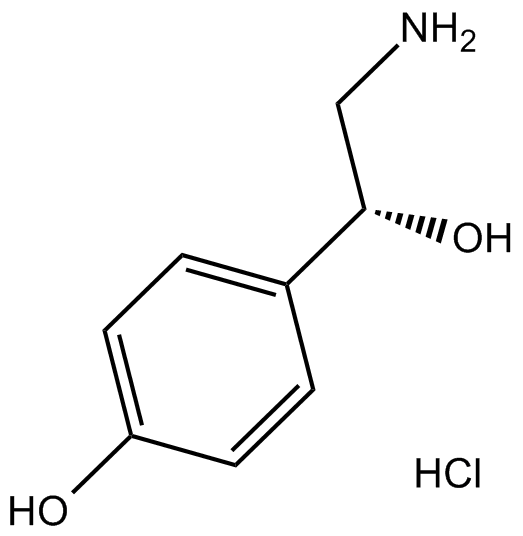(+,-)-Octopamine HCl (Synonyms: β,4-Dihydroxyphenethylamine, Epirenor, Norfen, NSC 108685, (±)-4-Octopamine, (±)-p-Octopamine) |
| Catalog No.GC10675 |
Octopamine ((±)-p-Octopamine) hydrochloride, a biogenic monoamine structurally related to noradrenaline, acts as a neurohormone, a neuromodulator and a neurotransmitter in invertebrates.
Products are for research use only. Not for human use. We do not sell to patients.

Cas No.: 770-05-8
Sample solution is provided at 25 µL, 10mM.
Octopamine hydrochloride ((±)-p-Octopamine hydrochlorid) is an endogenous biogenic amine that is closely related to norepinephrine, and has effects on the adrenergic and dopaminergic systems.Target: Dopamine Receptor; Adrenergic ReceptorOctopamine is present in relatively high concentrations in neuronal as well as in non-neuronal tissues of most invertebrate species studied, and modulates almost every physiological process. Octopamine acts as neurohormone including desensitization of sensory inputs, influence on learning and memory, or regulation of the mood of the animal in the central nervous system. Octopamine is the only neuroactive non-peptide transmitter whose physiological role is restricted to invertebrates, and all octopamine receptors belong to the family of G-protein coupled receptors [1].Octopamine (10 μM) injected into the mushroom body (MB) calyces or the antennal lobe but not the lateral protocerebral lobe produces a lasting, pairing-specific enhancement of extension of the proboscis. Octopamine (10 μM) injected into the MB calyces results in an additional pairing-specific effect, because it does not lead to an acquisition but a consolidation after conditioning [2]. Octopamine treatment significantly elevates levels of octopamine in the brain and caused a significant dose-dependent increase in the number of new foragers. Octopamine treatment is effective only when given to bees old enough to forage, i.e., older than 4 days of age. Octopamine influences division of labor in honey bee colonies [3].
References:
[1]. Roeder, T., Octopamine in invertebrates. Prog Neurobiol, 1999. 59(5): p. 533-61.
[2]. Hammer, M. and R. Menzel, Multiple sites of associative odor learning as revealed by local brain microinjections of octopamine in honeybees. Learn Mem, 1998. 5(1-2): p. 146-56.
[3]. Schulz, D.J. and G.E. Robinson, Octopamine influences division of labor in honey bee colonies. J Comp Physiol A, 2001. 187(1): p. 53-61.
Average Rating: 5 (Based on Reviews and 1 reference(s) in Google Scholar.)
GLPBIO products are for RESEARCH USE ONLY. Please make sure your review or question is research based.
Required fields are marked with *




















